A lot’s gone on in the thought leadership marketing world these past 12 months. For instance, social media, which played a yuuge role in the election of Donald Trump, has thoroughly captured the executive suite’s attention as an optimal channel for thought leadership marketing. According to Demand Gen’s 2016 “Content Preferences Survey Report, 85% of B2B buyers identified LinkedIn as a top channel for sharing business-related content. However, a 2017 Forbes/Deloitte survey of 300 global CXOs finds their preferred format for receiving business insights is feature-length articles and reports.
What’s a thought leadership marketer to make of that? Tweets or white papers? Blogs or research reports?
At the same time, the sheer volume of thought leadership being produced has raised the bar for the quality and quantity of material a B2B firm must develop. Not surprisingly, editors at leading third-party journals tell us they’re overwhelmed and no longer have time to work with sub-par submissions. If an article isn’t publication-ready, it will quickly be rejected. That puts more pressure on thought leadership marketers to produce impeccable work.
To cope with the furious pace of change transforming today’s thought leadership marketing landscape, these are the top ten things we think a firm should be doing. Because we’ve been in the business of thought leadership marketing a long time, we know that executives abhor unsubstantiated assertions. So, all our recommendations in this article are supported by data or examples. OK, here we go.
1. Create a content strategy.
Many firms claim they can’t publish good material in sufficient quantity to differentiate themselves in the market. And that’s validated by their target customers. A 2017 Edelman and PwC survey reports that 86% of business decision-makers found the thought leadership they consumed “only good, mediocre, or poor” in quality. That is, not differentiating.
Only 6% of B2B marketers rate their organization’s use of content marketing as “very effective.”
That shouldn’t be a surprise. Less than a third of marketers have a documented content marketing strategy, even though those that do are more effective in nearly all areas of content marketing, according to the B2B Content Marketing: 2016 Budgets, Benchmarks, and Trends study conducted by the Content Marketing Institute.
We know. Creating a coherent strategy is hard work. But without one, it’s impossible to focus on those issues your firm should own, the topics in which you have the expertise the market and the executives you are trying to reach are looking for. And, as no firm can possess cutting-edge thinking on everything, you must pick your battles. That means identifying the topics you want your firm to own and on which you will deliver breakthrough insights.
For example, over the last several years, McKinsey has consistently published articles on the Internet of Things (IoT). If you search on Google for IoT, a McKinsey primer leads the pack. But McKinsey focuses on a narrow range of IoT topics, primarily security, industrial opportunities, and artificial intelligence (AI). This focus may explain why McKinsey can boast over 100 major client IoT engagements over the past two years.
Several factors come into play when deciding what topics to own. One is a company’s level of expertise, and another is the opportunity or white space in the market (Figure 1). Topics on which the firm does not have market-leading expertise but competes might be candidates for publishing occasional insights gleaned from client work. And topics on which the firm’s expertise is on par with its competitors, and for which there remain few unanswered questions, might be good ones for marketing to ignore.
Figure 1: Picking Your Topics
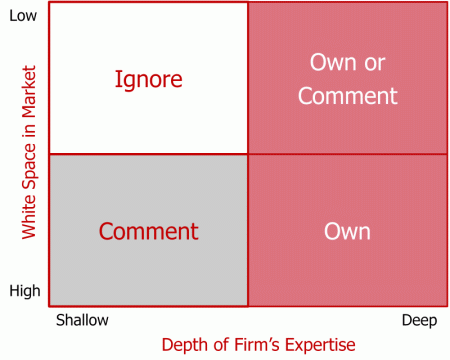
Focusing on a few topics to own isn’t an easy step for most firms because it involves deciding what not to do. But strategy is always about making tough decisions, and marketing is not exempt from the tough choices other parts of the business must make every day.
2. Go deep and move the market.
Executives embrace new ideas that are proven to work. From the assembly line to ERP to agile programming methods, the best ones have been developed by practitioners and research departments. The consultants and gurus who have later packaged and communicated them have been discoverers rather than inventors.
For example, Tom Davenport, then Director of Research at Babson College, decided to study how companies were using business intelligence (BI) software. Davenport interviewed managers at 32 companies to see what those that were using BI well were doing. That work turned into a Harvard Business Review article and then a book, Competing on Analytics: The New Science of Winning. Today business analytics is one of the fastest-growing services in consulting and IT. In 2017, Garter estimated BI and business analytics to be an $18.3 billion global market and still growing.
Davenport did not sit at his desk and dream up that market. Nor did he invent BI or analytics. He went out and looked at what was going on in an organized, documented manner. He did research, put it together, and created an insight that is still moving the market. You may have good material in-house already, but to create an insight that blows people away, as Davenport did, you will have to supplement that with primary research.
Some firms shy away from primary research because they think it’s risky. “What if we don’t find anything new?” they ask. But a systematic approach to thought leadership research always uncovers something new. And those new insights can inform product and service delivery, consolidating competitive advantage for the firm that produces or discovers them (Figure 2). The world is wide and rich with ideas, but they won’t come to you.
Figure 2. A Process for Intellectual Capital Development
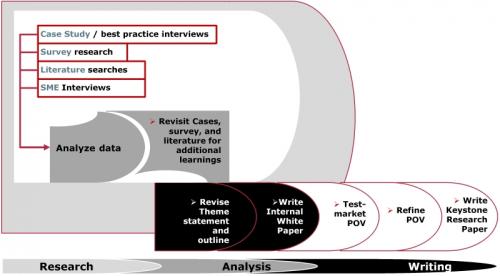
3. Industrialize content development.
Because standards are continually rising for both the quality and quantity of content, you can’t meet them without a process. In fact, you need at least two processes: one for developing content on the topics you want to own (where you are on safari for breakthrough insights), and one for developing content on the topics that you want to publish on from time to time, but don’t expect to be on the cutting-edge (Figure 3).
Figure 3. Approaches to Thought Leadership Development
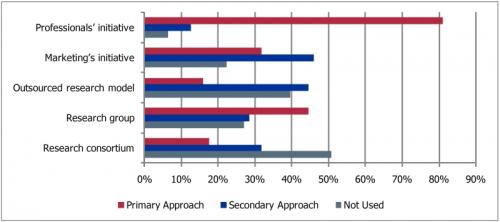
The right approach for creating research-based insights depends on the firm, especially its size and culture. For instance, you might set up your own research institute like McKinsey has with its McKinsey Global Institute, establish a research consortium or online community with clients like LexisNexis has, or partner with a university or research firm.
Using one of these approaches to do deep case study research can produce novel insights on how the best companies are solving a problem. Done well, this will produce a point of view that can support numerous articles, white papers, conference presentations, and webinars for each topic. That approach costs less and takes less time than developing the same number of pieces on different topics, and because they all derive from the same overarching point of view, the messages reinforce each other.
For example, a 2015 research report conducted by FTI Consulting, “What Companies Do Right (and Wrong) in Emerging Markets,” about managing risk, became the source material for articles bylined by seven FTI Consulting senior experts and published in the Harvard Business Review, Risk Management Monitor, Corporate Compliance Insights, and CFO.com. The study also was cited in the Wall Street Journal. FTI Consulting wanted to promote the depth and breadth of its expertise. One study and mission accomplished.
To produce a steady stream of insights from in-house expertise, a B2B firm needs a process that captures and augments it. There are two basic options: marketing-led and professional-led content development. In marketing-led development, marketers probe the organization to find good ideas that can be turned into thought leadership material. As Art Kleiner, editor-in-chief of PwC’s strategy& once told us: “We help client-facing staff crystallize their practice into thought.”
At other firms, especially those where SMEs are recognized and rewarded for their contribution to intellectual capital development, they propose ideas they want to publish, and marketing or an editorial board supports them in developing and articulating the point of view.
One important thing to bear in mind: Thought leadership content development is not a writing process; it’s an idea development process. The writing comes at the end, after the hard work of identifying new ideas and developing a novel, actionable point of view that aligns with the firm’s expertise and its ability to deliver corresponding services.
4. Deliver your content to where it’s valued.
Demand Gen’s 2016 Content Preferences Survey found email the overwhelmingly favorite channel (98%) for sharing business-related content. And the most effective email marketing strategy is to deliver content relevant to a particular audience segment (Figure 4). This makes sense. Most executives are besieged by content in their inbox from dawn ‘til dusk, and anything that isn’t or doesn’t seem relevant to them will be deleted.
Figure 4. Email Marketing: What Works, What Doesn’t
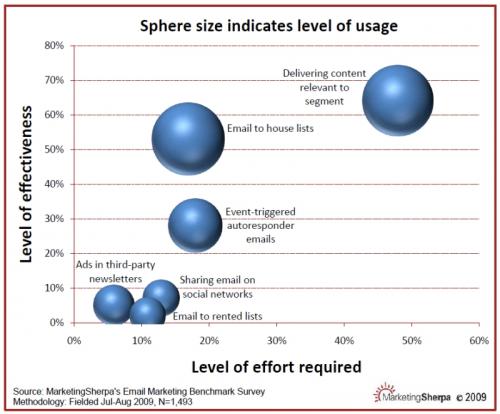
If you are a small firm with a single specialization, then just about anything you produce can go to everyone who has signed up for your newsletter. But if you are a larger firm, you’ll need a more sophisticated approach to make sure the right stuff gets to the right people. You can segment by demographics, but you can also give people the option to self-select the topics they are interested in. This markedly improves the chances the material will be read.
5. When possible, deliver it personally.
A 2015 Forrester survey reports that “74% of business buyers conduct more than half their research online before making an offline purchase.” That means that by the time a buyer speaks to a salesperson, the buyer’s mind is three-quarters made up. How did he or she make up his or her mind? That’s where marketing and your engaged SMEs come in. They get the firm’s thought leadership in front of prospective buyers early in the customer buying journey. That’s why marketing and sales need to be aligned and why it behooves your SMEs to help get your firm’s thought leadership in front of the right people.
A 2016 Aberdeen Group report found that “empowering marketers with visibility into sales utilization yields a 33% higher lead acceptance rate.” Furthermore, it found that best-in-class organizations are 28% more likely to deploy a formal process that aligns content with sales. (Figure 5).
Figure 5. An Integrated Sales and Marketing Process
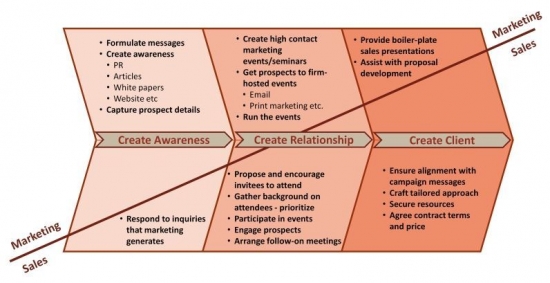
When marketing and sales are aligned, marketers and business developers are much more likely to promote the same services. This avoids wasted time, effort, and the dead ends that customers bump up against when they reach a salesperson with a request for which he is unprepared. If the account manager is the person who delivers marketing collateral to a client, he or she won’t be blindsided when the client asks to talk with someone about it. Plus, by personally delivering it, the account manager can help ensure that the firm’s thought leadership gets read. That’s more effective than any catchy headline.
6. Showcase your experts.
 B2B firms need to do more than publish in journals to showcase the authors of their articles and establish their authority. Getting published isn’t the goal; it’s a means to an end: Enhancing the reputation of a firm and encouraging people to contact the authors for advice. The first objective of an article or white paper is to attract and engage prospects; the next is to make them hungry for more – hungry enough to shoot off an email or pick up the phone to talk with these authors chock full of insight into the business buyers’ challenges.
B2B firms need to do more than publish in journals to showcase the authors of their articles and establish their authority. Getting published isn’t the goal; it’s a means to an end: Enhancing the reputation of a firm and encouraging people to contact the authors for advice. The first objective of an article or white paper is to attract and engage prospects; the next is to make them hungry for more – hungry enough to shoot off an email or pick up the phone to talk with these authors chock full of insight into the business buyers’ challenges.
At some point, if a prospect wants to talk, he or she will want to talk to a qualified professional. So, don’t be shy about showing off your authors’ credentials, and provide contact details along with links to their blogs and bios.
We sometimes hear firms say that if they make a big investment in promoting their professionals, that investment will have been squandered if the expert leaves. That’s a reasonable fear, and the reasonable response is to promote more than one professional or practitioner as an expert by having more than one byline on every article. When Paul Dunay, now U.S. Brexit Marketing Leader at PwC, was director of marketing at BearingPoint, he described his job as creating the rock stars, “and then the rock star would create the rock band – other people in the firm who could also be positioned as experts on the topic.”
That’s still good advice. A great example of professionals promoted well is the website of the law firm WilmerHale. Pick any of the articles on the firm’s website (say this one on alternate fee arrangements bylined by three of the firm’s partners) and click on any of the authors’ names. You’ll find their email address, phone number, bio, awards, published articles, speaking engagements, and recent professional highlights. This is a firm that’s proud to show off its practitioners’ experience and expertise and make them easy to reach. And if one of the three authors leaves for greener pastures, there are still the other two.
7. Formalize your social media strategy.
- LinkedIn is the most popular channel for distributing content, according to CMI, with 94% of marketers using it. That makes sense because the average CEO has 930 connections on LinkedIn, and 71% of professionals believe it’s a trustworthy source of information. Content marketers rank it first, at 66%, for effectiveness. Clearly, LinkedIn is a good place for your professionals and practitioners to engage in discussions and to post excerpts that lead their connections to your content.
- Twitter, used by 87% of B2B content marketers, recently surpassed Facebook as a B2B content marketing platform, with 55% of B2B marketers calling it “effective,” compared to only 30% for Facebook. Twitter provides an excellent way to monitor what’s going on in your field and point to the content you’ve published.
- YouTube is used by 74% of B2B content marketers because people, even business people, like watching videos. According to Insivia, 59% of executives would choose video over text, and over half of senior executives share work-related content with their colleagues every week. So, if you’re going to have an omnichannel strategy for disseminating thought leadership content, you can’t ignore video, and if you can’t ignore video, you can’t ignore YouTube.
- Facebook, used by 84% of B2B content marketers, has slipped behind YouTube and SlideShare. Increasingly, it’s a platform for B2C advertising, not B2B, which may be why the company’s value is rising astronomically. However, Facebook has its B2B uses, including finding people, recruiting talent, and tapping its community for ideas.
- Blogs According to HubSpot, companies that published over 16 blogs per month on their websites in 2016 got triple the traffic as companies that posted four or fewer. More traffic means higher Google rankings. Companies that posted over 16 blogs per month got over four times as many leads as companies that post four or fewer. In other words, get your professionals and practitioners blogging.
- Email Newsletters At 122%, email has a higher ROI than any other marketing format. So, it’s no surprise that 72% of content marketers ask their audience to subscribe to email newsletters. A subscription to a newsletter gives marketers information about who is interested in your company’s services and creates a continuing engagement with a possible lead. If done well, newsletters can turn subscribers into brand advocates.
8. Build microsites.
The most effective online marketing technique is a search-engine-optimized (SEO) website. The number of leads a business gets from its website goes up steeply with the number of pages that have been indexed by Google.
If you are sending newsletters, blogging, and publishing articles, you need somewhere to send people whose interests may lie in just one of the many topics you cover. These people are interested in the subject, but may not be ready to talk with you yet. At the same time, if you are publishing a lot of articles on that topic, you need a place to put them where they can reinforce each other and exhibit your deep expertise. The way to do that is to create a hub for each topic: a microsite.
For example, McKinsey publishes a lot of articles that cover the automotive space. If they were scattered throughout the main site, a company executive looking for help in that space, such as a supplier wondering how he fits into the new technology ecosystem of internet-connected cars, wouldn’t want to search the vast McKinsey site to find relevant information. Instead, he can go directly to McKinsey’s automotive and assembly microsite, find articles relevant to his business, see the McKinsey partners working in that space.
9. Make your content visually exciting.
When you use an online site as a hub for your content as opposed to a pdf or printed copy, there are many things you can do to make the material more engaging. Self-help tools, interactive graphics, and polls can make your content come to life. For instance, we can now include graphics that once were too large and complex to put on a page. We can show a reduced version that enlarges when the reader clicks on it.
Getting more sophisticated, the chart shown in Figure 6, published in BCG Perspectives, shows the growth in business strategy frameworks over time. But it also incorporates a huge amount of data about each that you can access by clicking on the corresponding dot. There is no way to do this in a print or pdf version of the page.
Figure 6. Making the History of Strategy Come Alive
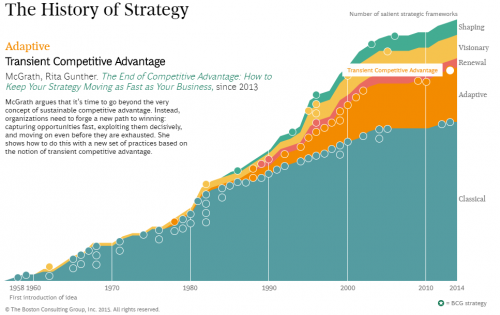
If a great picture is worth 1,000 words, then an interactive graphic that explains a complex concept is worth 1,000 pictures. Thought leadership is partly about explaining complex ideas simply but powerfully. Graphics or frameworks that order a chaotic topic are potent.
10. Ask your customers.
There’s a steady stream of market research material that all of us can use to give our customers what they want. But none of that research describes your customer. If you talk directly with clients and prospective clients about what they value, you’ll likely confirm some of the major truths of thought leadership marketing. But you may also discover nuances about their preferred delivery channels and pet peeves that can shine a new light on how you can do a better job of engaging them.



